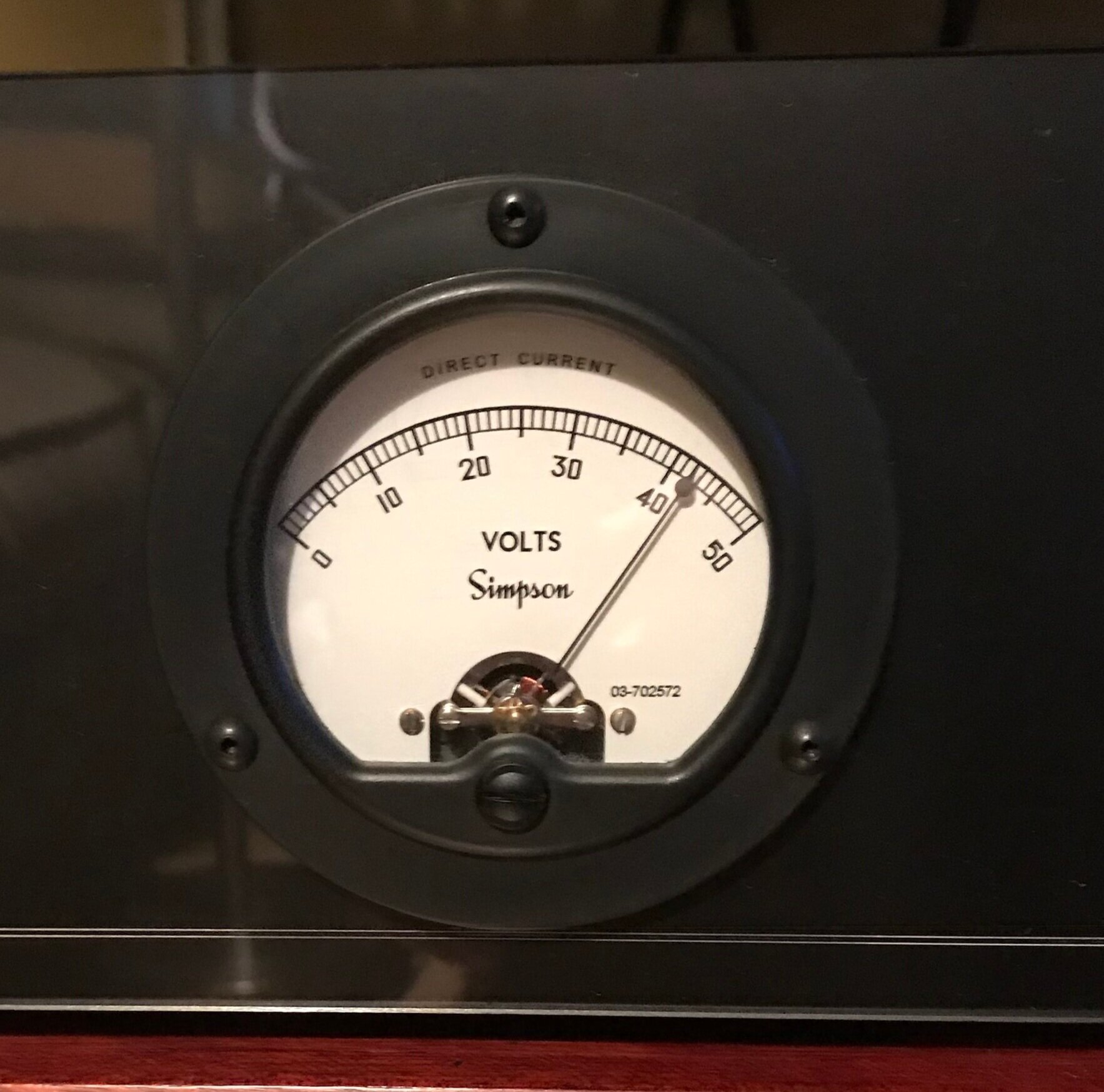During the Covid-19 pandemic I have been spending almost all my time indoors like most people. Other than a few parts supply issues because some of my suppliers have been forced to shutdown and slower shipping times, I have still made decent progress.
As part of the next major update to my preamp, I wanted to build a better panel meter and here is the front face plate of a prototype. The custom DÆ Panel Meter will replace the off-the-shelf traditional style panel voltmeter (pictured below) used in previous versions of the preamp .
DÆ v0.1 Panel Meter.
Traditional Style Panel Voltmeter
The history of the traditional style panel voltmeter goes back to the galvanometer of the early 1800’s. With two centuries of development these meters work incredibly well. While I love the traditional style panel voltmeter it has a few drawbacks in my application that I wanted to overcome with the custom DÆ Panel Meter.
First, the traditional meters are expensive! My initial idea was to build the DÆ Panel Meter with one of the X27 stepper motors used for automotive gauges. The X27 motors are inexpensive, readily available and designed specifically to make panel gauges so I thought they would be ideal. After much testing I found them just too noisy. These motors have tiny plastic gears that make noise when the meter needle moves. The X27 motors make even more noise when the meter needle is bounced off the end stop to home the meter. While you can get away with some noise in an automotive environment it simply won’t do in a high-end audio application. Also I found that these motors are not at all a typical bipolar stepper motor but instead are a "Lavet-type" stepper motor. You can read more about “Lavet-type” stepper motors in the attached link. These “Lavet-type” motors have unique stepping patterns which means I couldn’t directly use integrated circuits with noise reduction techniques like microstepping and voltage mode pulse width modulation (PWM).
Next I considered using the small Nema 14 stepper motor and Trinamic TMC2130 driver used in the DÆ v3.0 attenuator ladder section. This motor is a typical bi-polar stepper (direct drive, no gears) and the TMC2130 has the “stealthChop” voltage mode PWM for virtually silent operation. I probably could have got this to work but I also started testing a physically smaller 24BYJ48 stepper motor and a different Trinamic stepper driver TMC2300 and this proved to be the best answer.
The 24BYJ48 motor is a gear drive motor and I believe the gears are metal (but I haven’t taken one apart yet) which appear to mesh better than the plastic gears in the X27 stepper. In any event, the 24BYJ48 is quieter than the X27 right out of the box.
In addition to 256 microstepping and voltage mode PWM, the TMC2300 stepper driver has StallGuard4 for sensorless homing. Sensorless homing is ideal for the DÆ Panel Meter because it allows ultra-quiet homing (pointer bumping up against the end stop) when the meter is first powered-up.
Secondly, the traditional style panel voltmeter has a linear voltage scale. The fully charged battery pack voltage for my preamp is 41 to 42 volts. In the photos above you can see that at 41 to 42 volts the traditional style panel voltmeter needle is way over to the right hand side of the scale and most of the scale will never be used in normal operation. The battery pack voltage is expected to range from 36 volts when a recharge is a required to 42 volts fully charged.
The scale on the DÆ Panel Meter is highly nonlinear with the normal operating range of 36 to 42 volts occupying fully one third of the scale. The normal operating range is marked with a wider white band (see picture above). Like good automotive gauge design, the normal operating range of the DÆ Panel Meter is at “top-dead-center” (TDC) of the scale instead of way over to the right like it is in the traditional style panel voltmeter.
An interesting side note related to the scale on the DÆ Panel Meter is the combination of stepper motor and 256 microstepping results in almost a quarter million (229376 to be exact) steps for 315 degrees of needle sweep. This means that one step equals just over 0.001 degrees of needle movement. Now of course you couldn’t see one step but this precision allows a great deal of flexibility in designing the non-linear scale. Did I mention the non-linear scale of the DÆ Panel Meter is implemented in a microcontroller and is fully configurable in software?
One final note on comparing the DÆ Panel Meter scale to that of a traditional style panel voltmeter - the DÆ Panel Meter has a needle sweep of 315 degrees and 270 degrees is used for the voltage scale. I could have used 360 degrees just as easily but I was trying to get the DÆ Panel Meter to look and act something like a traditional style panel voltmeter. By comparison, the traditional style panel voltmeter has a needle sweep of only 110 degrees. Mind you 250 degree “long scale” meters are available but I guess at a higher cost.
An unexpected challenge of designing the DÆ Panel Meter is keeping the power consumption low. I wanted the DÆ Panel Meter to obtain all it’s required power from the voltage input terminals mimicking the traditional style panel voltmeter. Part of the two centuries of development of the traditional style panel voltmeter is a high input resistance which minimizes the impact of the meter load on the circuit being measured. As a result, the traditional style panel voltmeter has low power consumption. Getting anywhere close to this low power consumption with the DÆ Panel Meter has been a challenge. Tackling this challenge forced me to use (and as a happy by-product learn about) all the power reduction techniques of modern microelectronics like low voltage logic, sleep mode for the motor driver and microcontroller and a switching regulator. I think I have solved it.
Parts of the DÆ Panel Meter enclosure are being manufactured and after a little more testing of the switching regulator I will order the printed circuit boards. Another first for me will be outsourcing the board assembly because some of the surface mount components have absolutely tiny packages. For example the TMC2300 stepper driver only comes in a 3 mm x 3 mm package with 20 pins (QFN20) which is too small for me to hand solder. This is all part of modern electronics becoming smaller, lower powered and much more functional - all of these are benefits except they preclude hand assembly.
During the Covid-19 era I have also redesigned (again) the DÆ v2.1 phono preamp making it even smaller and better. The printed circuit boards for the latest version of the phono preamp are on the way to me. In addition, I am about 90% done a redesign of the battery charger/power supply making it smaller and better. More updates on both of these later…


